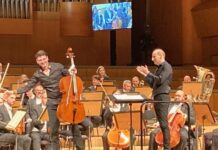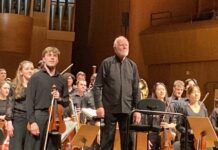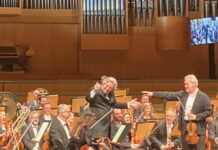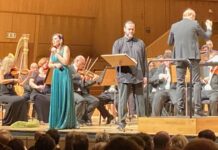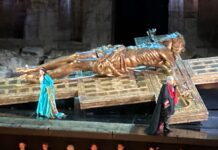by Kyriakos Loukakos, music critic of the Athens daily journal AVGI (Sunday edition) and www.criticscorner.gr e-magazine – Honorary President of the Greek Drama and Music Critics Union (est. 1928)

Quite a few operas depend as much and as crucially on the text they enrich as the 3-act and 12-scene «Dialogues des Carmélites» by Francis Poulenc (1899-1963), FP 159, the second one of this distinguished French composer. The composition followed a 1952 commission to Poulenc by Guido Valcarenghi, the director of the prestigious Italian editorial house Casa Ricordi, for a ballet to be presented at the Teatro alla Scala, Milan, about the Italian Franciscan Santa Margherita da Cortona (1247-1297). Poulenc declined the offer, but he couldn’t resist Valcarenghi’s second proposal, the «Dialogues des Carmélites», opting this time for an opera. The libretto is a free adaptation, by the composer himself, of a posthumous scenario by Georges Bernanos (1888-1948), based on the 1931 novel «Die letzte am Schafott» (fr. «La Dernière à l’échafaud», published in English as «The Song at the Scaffold») by Gertrud von Le Fort (1876-1971). According to the Catholic Studies Department of the Loyola University of Chicago, the German baroness was «a Catholic literary giant of the 20th century», who, through «her employment of sacramental realism would go on to influence, even if inadvertently, but often explicitly, the work of O’Connor, Greene, Bernanos, and others». She converted to the Roman Catholic Church in 1926 and, disgusted by the rise of Nazism in Germany, she declared about her novel that «the historical setting was only a garment for clothing a rather acute problem». The scenario was intended for a film that was not realized in the lifetime of neither Bernanos nor Poulenc, but it nevertheless formed the basis of a theatrical play created in May 1952.

We were initiated to this extraordinary work by the EMI 3lp record set under the baton of Pierre Dervaux, the conductor of the Paris Opéra premiere, on June 21, 1957, almost 6 months after its world premiere at the Teatro alla Scala, Milan on January 26, 1957, sung in an Italian translation by Flavio Testi. For years we had been deprived of an accompanying libretto, furthermore on a plot so improbable for operatic use. Nevertheless, this limitation enabled us to explore more directly the sophisticated lyricism that imbues the partition, years before we were graced by the viewing of memorable productions of the Met, La Scala and the Hamburg State Opera that acquainted us with the solid fundament of Georges Bernanos life changer of a text. Although religious in its initiative and purpose, Dialogues deal with universal basic elements of the human existence and the various aspects of its humanity, including love, devotion, duty, compassion, determination and lastly acceptance of fate, of others and of ourselves, our strengths and limitations, including the futility even of the highest human intentions vis-à-vis to coincidence of events. This is the fact that raises the characters of the work to palpable human beings and enables a deeply moving amount of sharing with them, throughout their Marche Au Supplice that depicts the true story of the Carmelite nuns’ martyrdom during the atrocities of the French revolution.

In this among other respects it says much about Poulenc that people so close to Bernanos, as Swiss author Albert Béguin, his friend and will’s executor, as well as assistant bishop of Paris Mgr. Daniel Pézeril, his confessor, coincided, the former in his acknowledgement of Poulenc’s accomplishment in adapting the text «remaining at the same time absolutely faithful to its spirit and to the major lines of a very delicate structure» and the latter in his gratitude because «Bernanos would tell you: thank you for having extended the sense of the word and for having invented alternatively the same mystery of Blanche’s assumption».
Therefore, it was a privilege to attend, for the first time in vivo, such an indisputable masterpiece in a place with the high esteem that Glyndebourne Festival enjoys in an international context of ever decreasing production standards, and on a very special occasion, since it proved to be the first ever production of the work in this prestigious venue, signed by one of the most interesting and least predictable directors of the 21st century, the Australian world citizen Barrie Kosky. He brought to the production his prize-winning German designer Katrin Lea Tag who invented a unifying scenery of an impersonal and intemporal corridor invoking alternately social and church, private and monastic confinements, without breach for the first half of the opera, depicting initially the aristocratic seclusion of Blanche and later the protective monastic one of the Carmelite order. The first invasion to the convent occurs by the plants surrounding the Old Prioress’s tomb at the interlude, while the breach of its wall, later literally bleeding, enhances the terrifying brutality of the warlike second part of the opera and the exposure of the characters to the outer world’s menace and ordeals.

While endorsing both direction and scenery, we were less enthusiastic about costumes, understandably unfaithful to any particular era but leaning to the widespread anonymity that one is uneager to combine with long standing Glyndebourne standards. Costumes were not helpful to the Blanche De la Force of the evening either (we attended the July 14th performance), the distinguished British soprano Sally Matthews, who replaced, not long before last minute, the initially -and all the way since 2020- foreseen Danielle De Niese. By some strange coincidence, the Australian born soprano had made her Glyndebourne debut back in 2005, as a superb Cleopatra in an all-round appraised production of Haendel’s «Giulio Cesare in Egitto», directed by David McVicar and conducted by Sir William Christie, a longtime reference on DVD. That memorable event, alongside a splendidly colourful «Die Zauberflöte», featuring among memorable others young Eric Cutler as Tamino, was also our first and to date only visit to the Festival, so we were really keen on witnessing De Niese’s commitment and overwhelming vocal and scenic personality in such a great role.
Although Sally Matthews was already acquainted with the part, she hardly rose to the demands of it, at times vocally uncertain, with less than clear text enunciation and scenically somewhat uninvolving. By her side the youthful Soeur Constance, as sung and enacted by young soprano Florie Valiquette enthralled us with by her clear diction and idiomatically metallic timbre as well as her vivid stage personality. Cast from strength were mezzo-soprano Karin Cargill and soprano Golda Schultz as Mère Marie de l’ Incarnation and Madame Lidoine respectively, both commanding imposing presence and emotionally intensive acting as the opposing candidates for the Old Prioress’s, Madame de Croissy, succession, a role that Katarina Dalayman defended with the stature that one expects from a veteran Brünnhilde of international repute. Among the male characters special mention befits young tenor Valentin Thill, as Blanche’s brother, the Chevalier de la Force, whom we had admired, some months ago, as Prince Bellidor in Dimitri Mitropoulos’s only opera «Sœur Béatrice», revived (14/10/2022) at the enterprising Olympia Musical Municipal Theatre “Maria Callas” of Athens.

The fact that such a special artist in French repertoire, as baritone Paul Gay indisputably is, has left less than a lasting impression as the Count de la Force, Blanche’s father, has more to do with Robin Ticciati’s conducting, following a steady pace of gradual culmination, an option that left much of the first part of the opera wanting in urgency and impact. This conceptual formality, while it enabled later stages of the action, such as the brother and sister farewell duet, to stress their point as a transitory milestone to the drama, disregarded the inner turmoil that pervades the story already since its very first scene, which also establishes Blanche ‘s astute singlemindedness. All in all, though, Poulenc’s masterpiece triumphed once more, assisted by Koskie’s deeply felt and thought out intensity as well as by a typical of Glyndebourne all-round high level of technical and musical craftsmanship.
Evergreen Peter Hall production of Britten’s “A Midsummer Night’s Dream”

Professionalism prevailed triumphantly also in the case of “A Midsummer Night’s Dream” by Benjamin Britten, a revival of an in-between legendary production by the late Sir Peter Hall, an all time classic of the Festival ’s history, which we had the belated privilege of attending on July 16th.
Based on a literary masterpiece of the calibre of the homonymous Shakespeare comedy, Britten’s opera is one of the most elusive to stage, especially in times largely evasive in terms of concrete stage relevance to the plot of an opera. Although acquainted with the old VHS tape of the original production in the early 1980s, we were instantly captured by its palpable stage power and its relentless level of magic, as recreated by revival director Lynne Hockney, incidentally the original choreographer of the production. Interestingly, the delightful impact of this otherworldly scenic atmosphere has retained aspects of human and forest interactions that relate inadvertently to our contemporary environmental awareness. The naturalistic scenery of moving trees and branches by John Bury, who also signed the exceptional fairy tale costumes, enhanced by Lauren Poulton’s delectably discreet and hypnotic choreography, Paul Pyant’s nocturnal lighting, the admirable acting and singing of boy soprano Oliver Barlow and his equally delightful Trinity Boys’ Choir’s fellow spirits, furthermore embodying and pronouncing the scenic word with admirable clarity of diction, as also the devoted playing of the London Philharmonic Orchestra under the baton of Glyndebourne debutante Dalia Stasevska, an alumna of Leif Segerstam and Jorma Panula, formed the frame of a memorable evening.

Countertenor Tim Mead, as a smooth sounding Oberon of regal chivalry, was the only artist known to us among an all-round strong cast of characters. The light lyric soprano of Liv Redpath, in her Glyndebourne debut as the fairy Queen Tytania, left its mark on the scenic proceedings, as did the characterful impersonations of Helena and Hermia by Lauren Fagan and Rachael Wilson respectively, on a comparably high level with their equally confused lovers, baritone Samuel Dale Johnson as Demetrius, a further promising Glyndebourne debut, and Caspar Singh’s cover as Lysander, lyric tenor Frederick Jones, who rose with impressive lightness to the luscious demands of his part. The cast included an unusually strong group of common folks (The Mechanicals), who offered memorable characterizations and full blooded, exact singing, headed by experienced bass-baritone Henry Waddington as Quince presiding over veteran tenor Alasdair Elliott as Snout, the impressive young bass Patrick Guetti as Snug, baroque oriented tenor James Way as Flute and baritone Alex Otterburn as Starveling, yet another Glyndebourne debut. Bass-baritone Dingle Yandell as King Theseus of Athens and mezzo-soprano Rosie Aldridge as his Queen Hippolyta rounded up a spectacle without a trace of wrinkle in its 42 years of existence, a truly collective feat of enduring excellence!




















